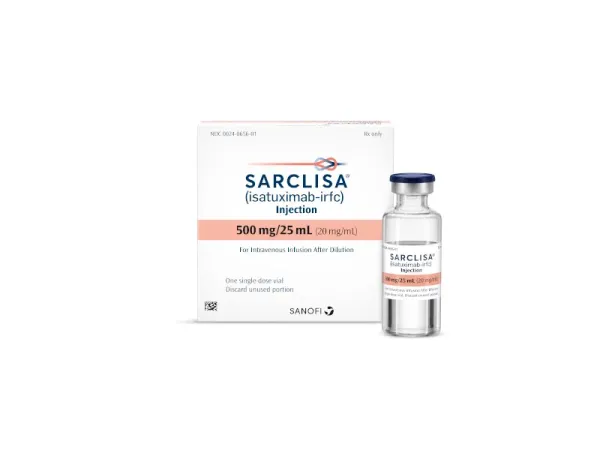Isatuximab Dosage
Medically reviewed by Drugs.com. Last updated on Apr 3, 2025.
Applies to the following strengths: irfc 20 mg/mL
Usual Adult Dose for:
Usual Geriatric Dose for:
Additional dosage information:
Usual Adult Dose for Multiple Myeloma
IN COMBINATION WITH POMALIDOMIDE AND DEXAMETHASONE:
- Cycle 1: 10 mg/kg IV on Days 1, 8, 15, and 22 (weekly)
- Cycle 2 and beyond: 10 mg/kg IV on Days 1 and 15 (every 2 weeks)
- Each treatment cycle consists of a 28-day period.
- Therapy is repeated until disease progression or unacceptable toxicity.
Recommended Premedications (administer 15 to 60 minutes prior to the infusion):
- Dexamethasone 40 mg orally or IV (or 20 mg orally or IV for patients 75 years or older).
- Acetaminophen 650 mg to 1000 mg orally (or equivalent).
- H2 antagonists.
- Diphenhydramine 25 to 50 mg orally or IV (or equivalent). The IV route is preferred for at least the first 4 infusions.
Use: In combination with pomalidomide and dexamethasone for the treatment of adult patients with multiple myeloma who have received at least 2 prior therapies including lenalidomide and a proteasome inhibitor
Usual Geriatric Dose for Multiple Myeloma
IN COMBINATION WITH POMALIDOMIDE AND DEXAMETHASONE:
- Cycle 1: 10 mg/kg IV on Days 1, 8, 15, and 22 (weekly)
- Cycle 2 and beyond: 10 mg/kg IV on Days 1 and 15 (every 2 weeks)
- Each treatment cycle consists of a 28-day period.
- Therapy is repeated until disease progression or unacceptable toxicity.
Recommended Premedications (administer 15 to 60 minutes prior to the infusion):
- Dexamethasone 40 mg orally or IV (or 20 mg orally or IV for patients 75 years or older).
- Acetaminophen 650 mg to 1000 mg orally (or equivalent).
- H2 antagonists.
- Diphenhydramine 25 to 50 mg orally or IV (or equivalent). The IV route is preferred for at least the first 4 infusions.
Use: In combination with pomalidomide and dexamethasone for the treatment of adult patients with multiple myeloma who have received at least 2 prior therapies including lenalidomide and a proteasome inhibitor
Renal Dose Adjustments
Data not available
Liver Dose Adjustments
Data not available
Dose Adjustments
No dose reductions are recommended. Dose delay may be required to allow recovery of blood counts in the event of hematological toxicity.
For information concerning drugs given in combination with this drug, see the manufacturer prescribing information.
Precautions
CONTRAINDICATIONS:
- Hypersensitivity to the active component or any of the ingredients
Safety and efficacy have not been established in patients younger than 18 years.
Consult WARNINGS section for additional precautions.
Dialysis
Data not available
Other Comments
Administration advice:
- This drug should be administered by a healthcare professional, with access to emergency equipment and medical support to manage possible infusion-related reactions.
- If a dose is missed, administer it as soon as possible and adjust the schedule accordingly, maintaining the treatment interval.
- Administer the solution by IV infusion using an IV tubing infusion set (in PE, PVC with or without DEHP, polybutadiene [PBD], or polyurethane [PU]) with a 0.22 micron in-line filter (polyethersulfone [PES], polysulfone, or nylon).
- The infusion solution should be administered for a period that will depend on the infusion rate.
- Use the prepared solution within 48 hours when stored refrigerated at 2C to 8C, followed by 8 hours (including the infusion time) at room temperature.
- Do not administer this drug concomitantly in the same IV line with other agents.
- Discard unused portion of solution.
Storage requirements:
- Store unopened product in a refrigerator at 36F to 46F (2C to 8C) in the original carton to protect from light. Do not freeze. Do not shake.
Reconstitution/preparation techniques:
- Inspect the product visually for particulate matter and discoloration prior to administration.
- The manufacturer product information should be consulted for reconstitution recommendations.
- The infusion bag should be made of polyolefins (PO), polyethylene (PE), polypropylene (PP), polyvinyl chloride (PVC) with di-(2-ethylhexyl) phthalate (DEHP) or ethyl vinyl acetate (EVA).
- Gently homogenize the diluted solution by inverting the bag. Do not shake.
IV compatibility:
- Sodium chloride injection; 5% dextrose injection
More about isatuximab
- Check interactions
- Compare alternatives
- Side effects
- During pregnancy
- Drug class: CD38 monoclonal antibodies
- Breastfeeding
- En español
Patient resources
Other brands
Professional resources
Other brands
Related treatment guides
See also:
Further information
Always consult your healthcare provider to ensure the information displayed on this page applies to your personal circumstances.


